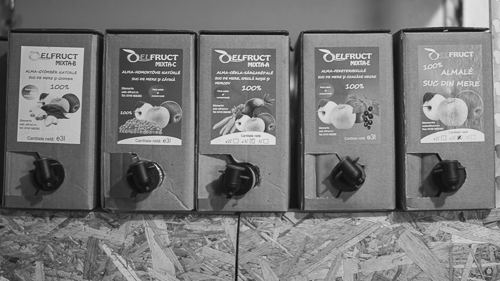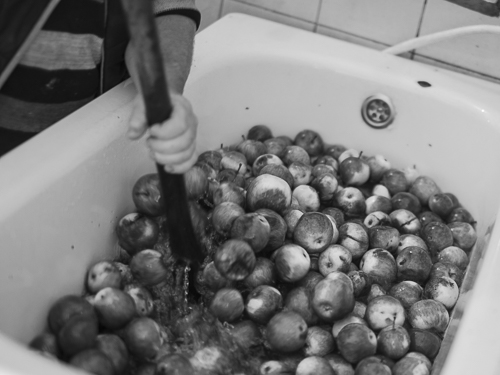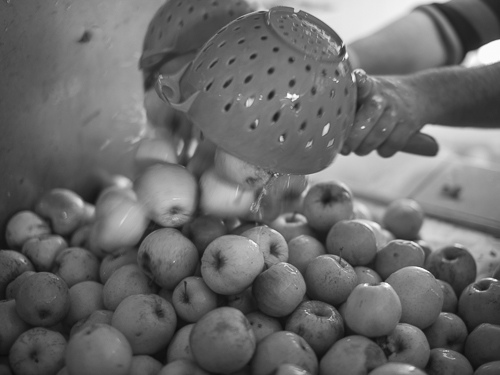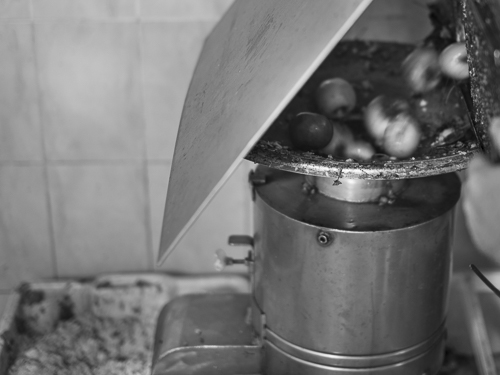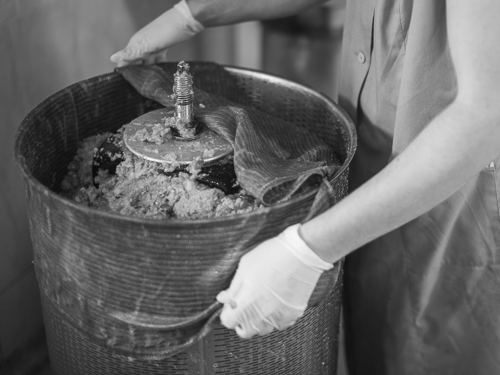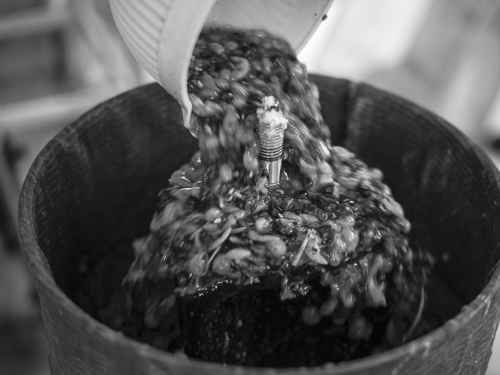Mr Jánó had back problems due to office work and he needed a change. 4 years ago, he decided to do something practical, setting up an apple press and growing blackberries and raspberries. His company is legal, taking no shortcuts and he’s expanding his business gradually. Last year there was a record apple harvest, but not so good this year. In fact, when we arrived on a Saturday, there were only two sacks of apples, which were waiting to be turned into apple juice.
Upon arrival, two young men or boys from a local school were also present. They were doing practise at the apple press, getting away from the classroom.
5 different types of juice without any preservatives or additives are produced at this combined fruit and vegetable press:
70% apple, 19,5% parsley, 10% celery, 0.5% lemongrass
90% apple, 10% ginger
90% apple, 10% sea buckthorn
85% apple, 15% pears
55% apple 35% beetroot carrot
All of them are, in general stored, in a 3 litres bag-in-box, but they also sell bottled juice. There’s a storeroom in the cellar where Mr Jánó stores blackberry wine made from his own blackberries.
The boys opened the sacks with apples and emptied them into a bathtub with water. Next, they stirred the apples to get rid of dust, then scooped them up by means of a perforated tool and laid them in a container with a hole at its base. Next, they pushed the apples into a funnel, which led to a machine that crushed the apples, letting the pulp end up in a big box below the fruit crusher.
There were two apple presses driven by water pressure. A big tank with hoses, one to each press, provided water to the the presses and served as a reservoir when compression of the apples were finished. When fruits should be compressed, water was pumped into two rubber balloons, expanding their volume. When compression was finished, water was pumped out again.
Before compression could begin, perforated metal cylinders were laid around each rubber balloon. A cloth was laid inside the cylinder and the pulp was laid inside the cloth.
One boy put the cloth around the pulp and packed it tightly on the top, then he put on a lid and attached it tightly. Next, he applied water pressure and apple juice started flowing out of the press, being collected in a gutter at the base of the metal cylinder and passing through a filter into a container from which it was pumped into another container. From there, it was pumped into a pasteuriser where the juice was heated to 82.5C. After having been cooled i a heat exchanger, it was pumped through a flowmeter where the owner filled up bag-in-boxes, 3 litres in each.
When the pressing of the pulp was finished, either of the boys disassembled the press. Next, both of them lifted the pulp inside the cloth and put in a wheelbarrow. Thereafter, they removed the cloth and rinsed all the parts of the press.
A lot of pulp and liquid was falling on the floor and either of the boys was scraping the floors often, pushing it into drains in the floors. They also sprinkled the floor quite often.
The work was repeated until l the almost all of the apples had been compressed. When the wheelbarrow was full, one of the workers brought the wheelbarrow to the combined blackberry and raspberry orchard and emptied the contents on the ground. Before, Mr Jánó gave the pulp to farmers, but now he uses it as compost in his orchard. After about 2 years, it is turned into soil.
After some time, a family arrived with about 100kg of grapes. Then, the boys put a grape machine on top of a huge bucket. Next, they poured the grapes into the machine which crushed the grapes. When it was finished, they carried the the pulp inside and poured it into the apple press. Mixing it with the remaining apple pulp, they made a combined apple and grape juice, which the family could bring back soon afterwards.
